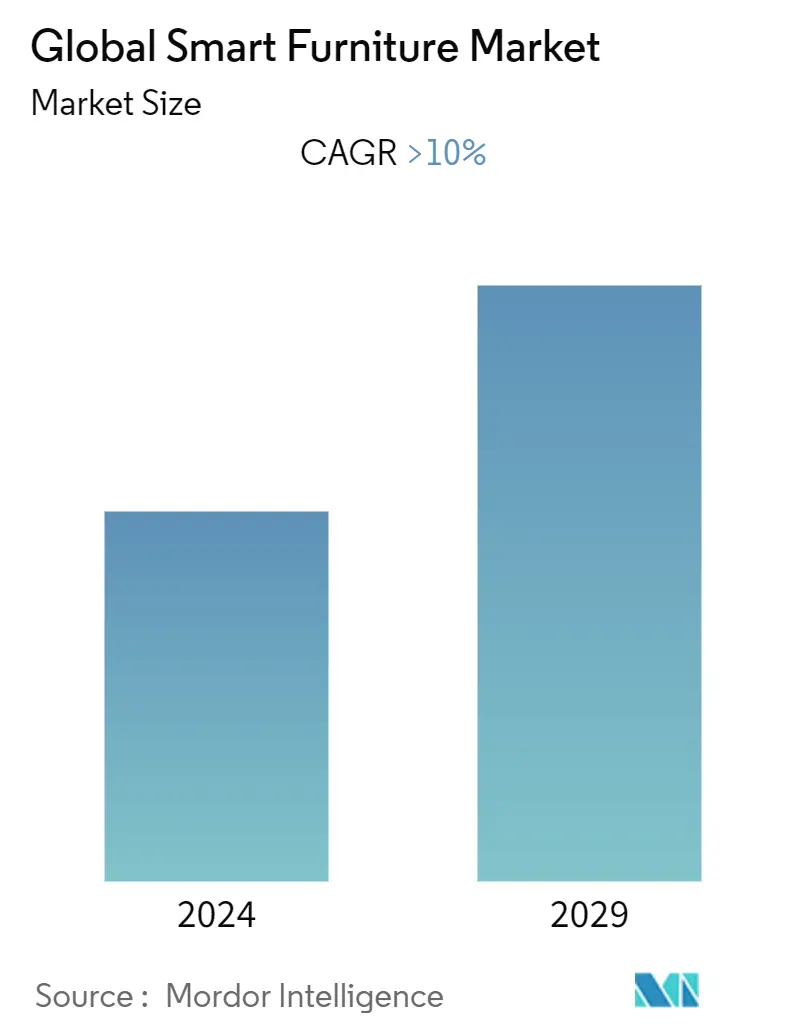Market Size of Global Smart Furniture Industry

| Study Period | 2020 - 2029 |
| Base Year For Estimation | 2023 |
| CAGR (2024 - 2029) | 10.00 % |
| Fastest Growing Market | Asia-Pacific |
| Largest Market | North America |
| Market Concentration | Medium |
Major Players
*Disclaimer: Major Players sorted in no particular order |
Need a report that reflects how COVID-19 has impacted this market and its growth?
Smart Furniture Market Analysis
The Global Smart Furniture Market is expected to register a CAGR of greater than 10% during the forecast period.
The wood industry, which necessitates a strategic algorithm of ethics, workmanship, devotion, patience, and discipline, is one of the key segments to be hit by the COVID-19. The lockdown has hindered business even though the market has consistently been growing for a number of firms.
The desire for ergonomic and useful office furniture among professionals who work from home is one of the main drivers promoting progress, along with the rise in the adoption of tech-savy workspace across corporate offices serving IT, research, and laboratories.
Due to greater discretionary income, consumers' lifestyles are altering substantially, particularly in urban regions. Professionals and workaholics lives are being made easier by the emergence of luxurious and technologically advanced products. In the upcoming years, this would help to drive the sector. Additionally, as people's discretionary money has increased, they have begun to consider their social status, which has resulted in greater spending on goods like furniture.
Smart Furniture Industry Segmentation
Smart furniture is a furniture with integrated technology such as sensors and intelligent systems to provide enhanced functionality, for example, coffee tables with wireless charging. A complete analysis of the global smart furniture market, which includes an assessment of the emerging market trends by segments, significant changes in the market dynamics and market overview, is covered in the report. The Global Smart Furniture Market is Segmented By Product (Smart Desks, Smart Tables, Smart Chairs, Other Smart Furniture), By End User (Residential, Commercial), By Distribution Channel (Home Centers, Specialty Stores, Online, Other Distribution Channels), By Geography (North America, Europe, Asia-Pacific, Latin America, Middle-East and Africa).
| By Product | |
| Smart Desks | |
| Smart Tables | |
| Smart Chairs | |
| Other Smart Furniture |
| By End User | |
| Residential | |
| Commercial |
| By Distribution Channel | |
| Home Centers | |
| Specialty Stores | |
| Online | |
| Other Distribution Channels |
| By Geography | |
| North America | |
| Europe | |
| Asia-Pacific | |
| Latin America | |
| Middle East and Africa |
Global Smart Furniture Market Size Summary
The smart furniture market is poised for significant growth, driven by the increasing demand for ergonomic and tech-savvy office solutions, particularly among remote professionals and corporate offices in sectors like IT and research. The market's expansion is further fueled by changing consumer lifestyles in urban areas, where higher discretionary income is leading to a preference for luxurious and technologically advanced furniture. The commercial sector remains the dominant force in the market, with new office constructions and renovations integrating modern design elements such as open floor plans and collaborative workspaces. This trend is expected to boost the demand for smart furniture, including smart desks, as businesses seek to enhance their office environments. Additionally, the residential segment is anticipated to grow due to increased demand for living room and bedroom furniture, spurred by government-led real estate construction projects in urban regions.
The smart furniture market is characterized by its fragmented nature, with numerous regional and international players competing for market share. Major companies like Inter Ikea Systems B.V., Herman Miller, and Steel Case Inc. currently lead the market, but technological advancements and product innovations are enabling mid-size and smaller companies to expand their presence. Strategic acquisitions, such as Steelcase Inc.'s purchase of HALCON and Herman Miller's acquisition of Knoll, Inc., are reshaping the competitive landscape, allowing these companies to enhance their product offerings and leverage combined capabilities. As the market continues to evolve, the focus on integrating technology with furniture design is expected to drive further growth and innovation.
Global Smart Furniture Market Size - Table of Contents
-
1. MARKET INSIGHTS AND DYNAMICS
-
1.1 Market Overview
-
1.2 Market Drivers
-
1.3 Market Restraints
-
1.4 Value Chain Analysis
-
1.5 Porter's Five Forces Analysis
-
1.5.1 Threat of New Entrants
-
1.5.2 Bargaining Power of Buyers
-
1.5.3 Bargaining Power of Suppliers
-
1.5.4 Threat of Substitutes
-
1.5.5 Intensity of Competitive Rivalry
-
-
1.6 Insights into Latest Trends and Technological Advancements in the Industry
-
1.7 Consumer Preferences and Behavior Analysis
-
1.8 Impact of COVID-19 on the Market
-
-
2. MARKET SEGMENTATION
-
2.1 By Product
-
2.1.1 Smart Desks
-
2.1.2 Smart Tables
-
2.1.3 Smart Chairs
-
2.1.4 Other Smart Furniture
-
-
2.2 By End User
-
2.2.1 Residential
-
2.2.2 Commercial
-
-
2.3 By Distribution Channel
-
2.3.1 Home Centers
-
2.3.2 Specialty Stores
-
2.3.3 Online
-
2.3.4 Other Distribution Channels
-
-
2.4 By Geography
-
2.4.1 North America
-
2.4.2 Europe
-
2.4.3 Asia-Pacific
-
2.4.4 Latin America
-
2.4.5 Middle East and Africa
-
-
Global Smart Furniture Market Size FAQs
What is the current Global Smart Furniture Market size?
The Global Smart Furniture Market is projected to register a CAGR of greater than 10% during the forecast period (2024-2029)
Who are the key players in Global Smart Furniture Market?
Inter Ikea Systems B.V., Herman Miller, Steel Case Inc, Sobro and Sleep Number Corporation are the major companies operating in the Global Smart Furniture Market.

